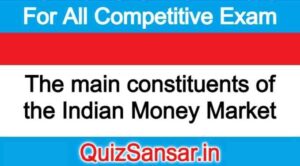
The main constituents of the Indian Money Market
Meaning of Money Market
Money market is the “collective name given to the various firms and institutions that deal in the various tools of near money.” It is a market for short-term loans in the sense that it provides money for working capital or circulatory capital. Most important short-term instruments with different degrees of maturity that are used in the money market are inter-bank call money, short-notice deposits, Treasury Bills of 91 days and 364 days, commercial bills, certificate of deposits and commercial paper. Money market is an institution through which surplus funds move to the deficit areas so that temporary liquidity crisis can be addressed. Money market enables inter-bank transactions of short-term funds. A well-knit money market acts as a ‘barometer for central banking operations. It enables the central bank to implement its monetary policy efficiently. In the absence of a well-coordinated banking system and other constituents of money market, the central bank may not be able to achieve its desired goals.
Constituents of Indian Money Market
The main constituents of money market are:
(i) Central bank,
(ii) Commercial banks, and
(iii) Indigenous banks and village moneylenders. India’s short-term credit market or money market consists of two sectors: (i) organised sector and (ii) unorganised sector. The organised market comprises of the RBI, the State Bank of India, commercial banks, the Life Insurance Corporation of India, the General Insurance Corporation of India, and the Unit Trust of India. These are the organised components of money market since the functions and activities of these institutions are systematically coordinated by the RBI and the Government. Also, cooperative banks fall in this category. The organised sector of the Indian money market can be divided into the following sub-markets:
(i) Call Money Market: The call money market is the market for very short-term funds such as overnight call money and notice money (14 days’) known as ‘money at call’. The rate at which the funds are borrowed in this market are called ‘call money rate’. Such rate is market-determined and influenced by demand for and supply of short-term funds.
(ii) Treasury Bill Market: By treasury bill we mean short-term liability of the Union Government. The treasury bill market issues treasury bills to meet the short-term financial needs of the Central Government. The unorganised sector comprises of indigenous banks and money lenders. This sector is outside the purview of government regulations. Even RBI has no control over this sector.
Features of Indian Money Market
The features of money market in India have been briefly discussed below:
1. Existence of Unorganized Money Market: An important feature of the Indian money market has always been the existence of the indigenous bankers who do not distinguish between short-term and long-term finance.
2. Absence of Integration: Indian money market divides the money market into several segments or sections, loosely connected to each other.
3. Diversity in Money Rates of Interest: Another feature of the Indian money market is the existence of too many rates of interest, viz. the borrowing rate of the Government, the deposit and lending rates of commercial banks, deposit and lending rates of cooperative banks, etc.
4. Seasonal Stringency of Money: A very striking characteristic of the Indian money market is the seasonal monetary stringency and high rates of interest during a part of the year.
5. Absence of the Bill Market: Another feature of the Indian money market is the absence of a bill market or a discount market for short term bills. A well organized bill market is necessary for linking up the various credit agencies ultimately and effectively to RBI. However, an effective bill market is absent in India.
6. Highly volatile call money market: Indian Money Market is characterised by a highly volatile call money market. Even RBI has failed to be able to regulate it.
7. Absence of a Well-organized Banking System: Another major feature of the Indian money market is the absence of a well-organized banking system.
8. Availability of credit instruments: Till 1985-86, the India money market did not had adequate short-term paper instruments. Apart from the call money market, there was only the Treasury bill market. At the same time, there were no specialist dealers and brokers dealing in different segments of the Indian money market and in different kinds of paper instruments.
In view of all the above mentioned features we may come to the conclusion that the Indian money market is relatively under developed.
Demerits of Indian Money Markets
Indian money market is regarded as underdeveloped money market. The main shortcomings of Indian money market are as follows:
1. Absence of Coordination: There is no coordination between organised and unorganised sectors of the money market. At times there is even wasteful competition between them. Such a situation is extremely harmful for the economic progress of the country.
An important shortcoming of Indian Money Market is the absence of a well developed money market. Though both inland and foreign bills are traded in Indian Money Market yet its scope is very limited. In spite of the efforts of Reserve Bank in 1952 and in 1970, only a limited bill market exists in India. The main obstacles in the development of bill market are as follows:
(1) The lack of uniformity in drawing bills in different parts of the country.
(ii) The large use of cash credit as the main form of borrowing from commercial banks,
(iii) Presence of Inter-call money market and
(iv) The pressure of cash transactions..
Thus, Bill Market is relatively underdeveloped.
3. Shortage of Funds in Money Market: The Indian money market is characterised by shortage of funds. The funds available in the market are inadequate to meet the requirements of trade and industry. The main reasons responsible for shortage of funds are poverty, low level of income and low savings and inadequate banking facilities.
4. Seasonal Stringency of Funds: Another defect of Indian Money Market is the stringency of credit in particular seasons of the year. During the harvest time (April to November) there is substantial rise in demand for credit. The supply of credit at such a time does not increase in the same proportion in which demand increases. Consequently, rate of interest shoots up during the busy season. On the other hand, during the slack season, due to fall in demand for credit, the interest rate declines.
5. Lack of Uniformity in Interest Rates: In Indian Money Market, there is no uniformity in rates of interest. The lending rates of commercial banks differ from those of the Rural Regional Banks and cooperative banks. There is also wide variation in the rates of interest charged by the banks of organised sector and of indigenous banks.
6. Underdeveloped Banking Habits: Inspite of rapid branch expansion of banks and spread of banking to unbanked and rural centres, the banking habits in India are still underdeveloped. There are several reasons for it.
(1) Whereas in U.S.A. for every 1400 persons there is a branch of a commercial bank, in India there is a branch for every 13,000 people, (ii) The use of cheques is restricted, (iii) The majority of transactions are settled in cash, (iv) The hoarding habit is widespread.
7. Dominance of Indigenous Bankers: The indigenous banker still dominates the banking scene in India. Even after banking expansion in the rural areas, the money lenders still continue to be the only source of finance for the agriculturists. They exploit their customers by adopting malpractices and charging exorbitant rate of interest The Reserve Bank exercises no control over them.






